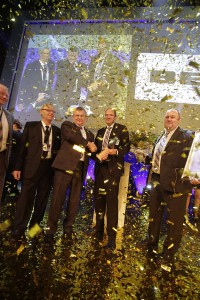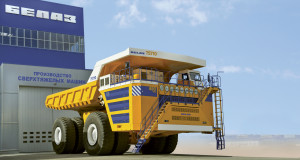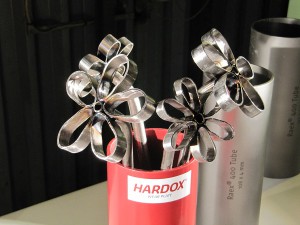The ceremony for the 16th swedish steel prize-giving was held in stockholm last november. The travel to sweden was the opportunity to see from close up the birth of high strength steels that are increasingly used as main ingredient in the implementation of innovative and eco-sustainable products.
The Swedish Steel Prize is the award deemed as the Nobel prize for the innovative use of the SSAB-branded high strength steel. To astonish customers and the international press, the company has opened the doors of two productive Swedish factories, Borlänge and Oxelösund. We tell you what we have seen.
The visit to Borlänge
This production site, situated to the north of Stockholm, is the oldest factory of SSAB. In about 4 hours of visit, SSAB’s guests could see what follows:
Hot rolling
In the hot rolling mill, thick slabs are transformed into coils with different thicknesses and widths. Part of the production is directly forwarded to customers while the rest undergoes further processes (pickling, cold rolling or heat treatment). In the hot rolling mill, the thickness of the heated thick slabs decreases from 200 mm to about 30 mm in 5 stages, onwards and backwards. Afterwards the material is rolled, up to a thickness included between 16 and 1.8 mm in a single step through 6 stands at the speed of 36 km/h. Once achieved the thickness of 2 mm, the sheet metal reaches a length of about 1300 m. When the final phase is accomplished, sheet metals are hardened in a cooling plant, in more or less time depending on the different strength they want to obtain.
Cold rolling
The cold rolling is recommended when more precise thicknesses and smoother surfaces are demanded. Such process is carried out in the tandem train of rolls where sheet metals are cold rolled in five successive stands. Each stand is composed by two working rolls and two supporting rolls. The cold rolling makes the sheet metal become fragile and hard in the first phase. This because the grains of the steel structure are deformed and extended. Hence the need of subjecting cold rolled sheet metal to annealing. The heating up to a defined temperature causes the growth of new grains to the detriment of deformed ones, thus recovering the sheet metal formability.
Flattening lines
The flattening line is new at Borlänge factory’s and it was installed to flatten the ultra-high strength steel directly from the hot rolling mill. The line, produced in Italy, can cut sheet metals with lengths ranging from 1 to 16 metres and with thicknesses included between 1.8 and 8 mm. The levelness in the flattening line is obtained by a straightener, at the beginning of the line and by two levelling machines afterwards. This setup assures the desired levelness. The coil is cut by using shears having the same speed of the material in relation to cutting, up to 60 metres per minute. After cutting, sheet metals are stacked and transferred to the packaging line, then they are piled up and transported to the warehouse.
Tubes
Three are the lines able to produce tubes with diameters from 14 to 133 mm, with thickness from 0.5 up to 6 mm. All lines are equipped with water furnace that allows the production of Hardoc and Weldox tubes without thermally altered zones. The main products by SSAB remain anyway Docol R8 and Hardox 500 tubes. Docol R8 have been approved for the implementation of roll bars for the drag racing while Hardox 500 are ideal for the transport of abrasive materials like cement, fly ashes, coal dust and slurries.
Coated products
SSAB plants consist of four lines for the metal coating and of four continuous lines for the pre-painted one. At Borlänge are installed a galvanizing and a pre-painting line. The galvanized steel produced is used for several applications that go from spiral ventilation tubes to safety frames for the automotive sector. The pre-painted products, avaiIable in various colours, are instead used for the building industry.
The visit to Oxelösund
The SSAB factory at Oxelösund is the reference point for the manufacturing of plates and is organized with a complete production line that starts from raw materials up to including thin rolled sections. Summarizing the entire process:
• the coking plant converts carbon into coke and gas through a gang of sealed furnaces; the gas is turned into energy and the coke is conveyed to the plant in continuous with pellets of iron ore, limestone and additives;
• the hot metal is cast as soon as the steel plant reaches the correct temperature and slags are separated in a collection tank, which can contain up to about 300 t of material;
• the metal – treated in such a way as to eliminate the sulphur in excess – and cooling residues are loaded on an apposite converter and oxygen is bound with carbon. Alloy elements are added when the steel is cast from the converter into apposite ladles.
• in the continuous casting process, the steel is then transformed from cast material into thick slabs.
The rolling mill (equipped with four rolls) is defined the “core of the steelworks” and includes the spectacular process that leads thick slabs to be transformed into sheet metals with the desired sizes. The thickness is reduced from 220 to 3 mm; widths, instead, can rise from 1,000 to 3,350 mm, while lengths from 2 to 14.5 m. In the hardening line, the sheet metals coming from the rolling mill are instead cooled, hardened, worked and painted according to the specific requirements, before forwarding them to customers. At the end of the tour, customers could directly try “to trace” some possible defects on sheet metals through the ultrasound technology.
 Belaz wins the Swedish Steel Prize 2014
Belaz wins the Swedish Steel Prize 2014
The winner of the sixteenth edition of the international Swedish Steel Prize is the Belarusian Company Belaz. The prize was given to the company in virtue of the innovation made in the manufacturing of the suspension of the axles and bearings of the biggest dump truck in the world. The new construction fully exploits the properties of the high strength steel. Belaz has bravely widened the borders of what was previously deemed possible thanks to the available technique», says Gregoire Parenty, President of the Jury and Executive Vice-President, as well as Head of the market Development Department of SSAB. The current trend in the sector of the quarrying and mining industry worldwide is “bigger is better”. The demand is high, therefore the production must be optimized. To achieve this target, Belaz, the global producer of dump trucks for mines, has created the biggest dump truck in the world, with a payload capacity surpassing standard trucks by 20% (a good 450 tons), at the same time minimizing the fuel consumption and attaining a minor cost per load.
The range of high strength steels
The high strength steels that leave SSAB production sites are different, with their own peculiarities for different applications. Seven are the families that group the various products:
-DOMEX, structural steels characterized by unique properties in terms of strength, cold forming, tight bend radius, toughness at low temperatures, weldability and suitability for laser cutting.
-HARDOX, anti-wear sheet metals for a bigger capacity and longer service life suitably used in all those components affected by strong wear, then needing extraordinary resistance to cracks.
-DOCOL, the trademark dedicated to automotive sector companies. DOCOL steels are used for the safety components of cars. Producers can reduce the weight and increase the percentage of recyclable parts. Docol is 100% recyclable, it can be easily treated and formed in complex shapes and can drastically reduce the weight of automotive components thanks to its strength.
-WELDOX, construction structural steel that allows implementing lighter but at the same time stronger structures thanks to its high yield strength.
-PRELAQ, pre-painted sheet metal mainly used for covering roofs and coating building walls.
-ARMOX, family of specific steels for the construction of light armoured vehicles, personal protections and safety vehicles where the highest protection need must be coupled with mobility and lightness.
-TOOLOX, Pre-hardened steel for tools to reduce production costs.




